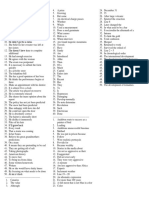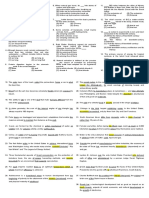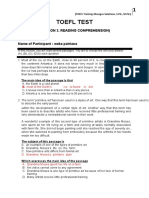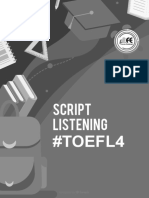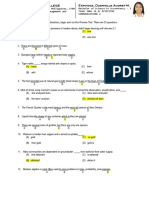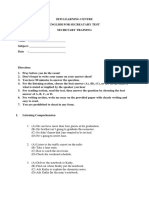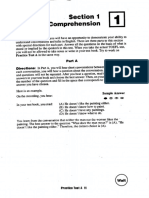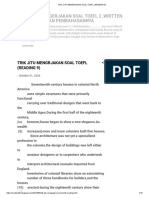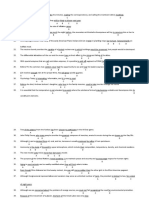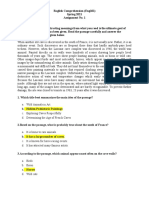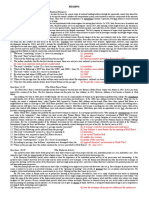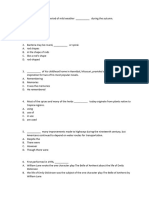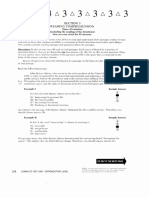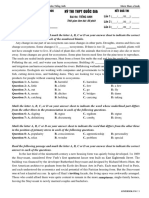0 ratings0% found this document useful (0 votes) 312 views11 pagesC. Reading Comprehension
Copyright
© © All Rights Reserved
We take content rights seriously. If you suspect this is your content,
claim it here.
Available Formats
Download as PDF or read online on Scribd
SECTION 3
READING COMPREHENSION
Time—55 minutes
(including the reading of the directions)
Now set your clock for 55 minutes.
This section is designed to measure your ability to read and understand short passages similar in
topic and style to those that students are likely to encounter in North American universities and
colleges.
tions: In this section you will read several passages. Each one is followed by a number of
questions about it, You are to choose the one best answer, (A), (B), (C), or (D), to each question. Then,
on your answer sheet, find the number of the question and fill in the space that corresponds to the
letter of the answer you have chosen.
‘Answer all questions about the information in a passage on the basis of what is stated or implied in
that passage.
Read the following passage:
John Quincy Adams, who served as the sixth president of the United States from 1825
to 1829, is today recognized for his masterful statesmanship and diplomacy. He dedicated his
life to public service, both in the presidency and in the various other political offices that he
Line held. Throughout his political career he demonstrated his unswerving belief in freedom of
(5) speech, the antislavery cause, and the right of Americans to be free from European and Asian
domination.
Example 1 Sample Answer
To what did John Quincy Adams devote his life? 2
(A) Improving his personal life
(B) Serving the public =
(©) Increasing his fortune
(D) Working on his private business
According to the passage, John Quincy Adams “dedicated his life to public service." Therefore, you
should choose (B)
Example IT Sample Answer
In line 4, the word “unswerving” is closest in meaning to
(A) moveable
(B) insignificant
(C)_ unchanging
(D) diplomatic
8008
The passage states that John Quincy Adams demonstrated his unswerving belief “throughout his
career.” This implies that the belief did not change. Therefore, you should choose (C).
Now begin work on the questions.�Line
(5)
(10)
Questions 1-10
In west-central New York State there is a group of eleven long, narrow, glacial lakes known as the
Finger Lakes. From east to west these lakes are Otisco, Skaneateles, Owasco, Cayuga, Seneca, Keuka,
Canandaigua, Honeoye, Canadice, Hemlock, and Conesus
These lakes have been aptly named because of their resemblance to the fingers of a hand. Two of
the largest of the Finger Lakes, Seneca and Cayuga, exemplify the selection of the name: Seneca fe
thirty-seven miles long and four miles across at its widest point, and Cayuga is forty miles long and two
miles across.
Although scientists are not completely certain as to how these lakes were formed, most believe
that successive sheets of glacial ice carved out the long, narrow valleys. The glaciers most probably
moved along the paths of preexisting stream valleys and further deepened these valleys to depths well
below sea level, With the melting of the glaciers at the end of the Ice Age, the lakes were filled
The topic of this passage is 4. Why does the author mention Seneca and
(A) west-central New York State Cayuga in the second paragraph?
(B) Seneca and Cayuga (A) They are the only two Finger Lakes
(©) the description and origin of the (B) They are the two largest lakes in the
Finger Lakes United States.
(D)_ the scientific findings about the (©) They are good examples of long and
Finger Lakes narrow lakes.
(D) They are long and wide.
2. The word “glacial” in line 1 is closest in
meaning to which of the following? 5. The word “selection” in line $ is closest in
ey meaning to
@) Thin (A) sound
(©) Shallow (B) choice
(D) Wide (C) feeling
(D) presentation
3. According to the passage, why are these
lakes known as the Finger Lakes?
The passage implies that Seneca Lake is
(A) They are the same size as fingers. (A) a constant four miles wide
(B) Their shape is similar to a finger’s. (B) at least four miles wide at each point
(C)_ Their composition is the same as a (C)_ wider than it is long
finger's. (D) narrower than four miles at certain
(D) There are as many lakes as there are points
fingers�a
What do most scientists believe caused the 9
formation of the Finger Lakes?
(A) The sea level decreased.
(B) Heavy rainfalls flooded the area.
(C)_ Melted glaciers carved out the
valleys.
Glaciers cut into the land and then
melted to fill the valleys. 10.
)
The word “successive” in line 9 could best
be replaced by
(a)
(B)
«©
(D)
timely
duplicate
sequential
simultaneous
The word “paths” in line 10 is closest in
meaning to which of the following?
(A) Waves
(B) Routes
(C) Sands
(D) Highways
What is the tone of this passage?
(A) Informative
(B) Accusatory
(C) Humorous
(D) Calculating�Line
(5)
(10)
Questions 11-20
Popular architecture in the United States in the beginning of the twentieth century continued as it
had at the end of the nineteenth century, with elaborately ornate historical motifs. The new skyscrapers
sprouting up at the time were often ornately finished with elements of Gothic or Roman detailing.
During this period of emphasis on intricate ornamentation, certain architects began moving in a
different direction, from the historic attention to ornate detailing toward more modern design typified
by simplified flowing lines.
Frank Lloyd Wright, the best known of these early modern architects, developed a style that he
termed organic architecture, a building style based on natural forms rather than on the intricately
detailed styles that had been popular. Wright started work in Chicago designing “prairie houses,” long,
Jow buildings featuring flowing horizontal lines and simplistic unity of design. These buildings often
centered around massive stone fireplaces with rooms open to each other and space flowing from one
room to the next; they were intended to fit the wide open expanses of the Midwest Plains that served as
a setting for Chicago. These “prairie houses," found in Chicago's suburban areas, served to tie the
rapidly developing neighborhoods of Chicago with its Plains heritage.
11. The paragraph preceding this passage most 14. The expression “sprouting up” in line 3
probably discussed could best be replaced by
(A) popular music (A) being grown
(B) simpler forms of architecture (B) dominating,
(©) the development of Chicago (©) popularized
(D) architecture in the nineteenth (D) being built
century
15. The word “simplified” in line 6 is closest in
12. What is the main idea of this passage? meaning to
(A) The architectural style of Frank Lloyd (A) basic
Wright represented a change from (B) not difficult
earlier styles. (©) straight
(B) Architecture in the twentieth century (D) recent
was very ornate,
(©) Frank Lloyd Wright’ architecture 16. Which of the following statements about
was more elaborate than previous Frank Lloyd Wright is supported in the
styles. passage?
(D) Frank Lloyd Wrights “prairie houses”
omeattiiegien teas (A) He was extremely popular prior to
the twentieth century.
(B)_ He used elements of Gothic and
Roman detailing in his work.
(©) His architectural style can be seen in
Chicago's skyscrapers.
13. According to the passage, the new
skyscrapers built at the beginning of the
twentieth century were
(A) elementary (D) His “prairie houses” were very
(B) elaborately ornamented different from the elaborately
(©) ina very modern style ornamented skyscrapers,
(D) completely Gothic�hae
18,
‘The “prairie houses” built by Frank Lloyd 19,
Wright were
(A) ommately detailed
(B) built in the Roman style
(C) skyscrapers
(D) flowing and simple
The word “fit” in line 12 could best be
replaced by 20.
(A) match
(B) wear
(Cc) try
(D) fill
tis implied that Frank Lloyd Wright's
“prairie houses” resembled the prairies
around Chicago in that
(A) they were covered with grass
(B) they were rapidly developing
(©). they were long and low
(D) they were in Chicago
The word “heritage” in line 14 is closest in
meaning to which of the following?
(A) Ambiance
(B) Tradition
(©) Appearance
(D) Surroundings�Line
(5)
(10)
Questions 21-30
Louisa May Alcott, an American author best known for her children’s books Little Women, Little
‘Men, and Jo’ Boys, was profoundly influenced by her family, particularly her father. She was the
daughter of Bronson Alcott, a well-known teacher, intellectual, and free thinker who advocated
abolitionism, women's rights, and vegetarianism long before they were popular. He was called a man of
unparalleled intellect by his friend Ralph Waldo Emerson. Bronson Alcott instilled in his daughter his
lofty and spiritual values and in return was idolized by his daughter.
The financial situation of the Alcott family during Louisa’s childhood was not good, mainly due to
the fact that her father made unsound investments in projects that reflected his idealistic view of the
world. As a result, Louisa had to begin helping to support her family at a young age, by taking a variety
of low-paying jobs as a seamstress, a maid, and a tutor,
Her novel Little Women was patterned after her own family, and Louisa used her father as a model
for the impractical yet serenely wise and adored father in Little Women. With the success of this novel
she was able to provide for her family, giving her father the financial security that until then he had
never experienced.
21. The passage mainly discusses 24, Inline 6, the word “lofty” is closest in
(A) Louisa May Alcott’s famous books cibeaeeiciad
(B) how Bronson Alcott implemented his (A) commonplace
‘educational philosophies (B) high-minded
(©) the success of Little Women (© self-serving
(D) Bronson Alcott’ influence on his (D) sympathetic
daughter
25. The word “unsound in line 8 is closest in
22. The word “particularly” in line 2 is closest ‘meaning to which of the following?
in meaning to ;
(A) Noiseless
(A) in part by (B) Unprepared
(B) strangely (©) Unsafe
(©) except for (D) Unheard
@)
26. Which of the following is NOT implied as
23. The passage implies that vegetarianism something that Louisa did to earn money
asa youth?
(A) was more popular than abolitionism
(B) was the reason for Louisa’s adoration (A) She did some sewing.
for her father (B) She cleaned houses.
(©) became popular in a later period (©) She taught.
(D) was one of the reasons for Bronson (D) She worked in a store.
Alcott’s unparalleled intellect�27.
28,
The expression “provide for” in line 13
could best be replaced by
(A) support
(B) identify with
(©) buy presents for
(D) manage
It can be inferred from the passage that
Louisa May Alcott used the success of Little
Women to
(A) buy herself anything she had ever
wanted
(B) achieve personal financial success
(©) give her father tangible proof of her
love
(D) detach herself from her family
29,
30,
The author's purpose in the passage is to
(A) explain how an author becomes
famous
(B) describe the influence of family on a
writer
(C)_ support Bronson Alcott’s educational
theories
(D) show the success that can be
achieved by an author
Where in the passage does the author
mention examples of the beliefs of Louisa’s
father?
(A) Lines 1-2
(B) Lines 2-4
(©) Lines 7-9
(D) Line 11-12�Line
(5)
(10)
(us)
(20)
Questions 31-41
In the American colonies there was little money. England did not supply the colonies with coins
and it did not allow the colonies to make their own coins, except for the Massachusetts Bay Colony,
Which received permission for a short period in 1652 to make several kinds of silver coins, England
ica as a means of controlling trade: America was forced to trade
wanted to keep money out of Ame
only with England ifit did not have the money to buy products from other countries. The result during
this prerevolutionary period was that the colonists used various goods in place of money: beaver pelts,
Indian wampum, and tobacco leaves were all commonly used substitutes for money. The colonists also
made use of any foreign coins they could obtain. Dutch, Spanish, French, and English coins were all in
use in the American colonies.
During the Revolutionary War, funds were needed to finance the war, so each of the individual
states and the Continental Congress issued paper money. So much of this paper money was printed
that by the end of the war, almost no one would accept it. As a result, trade in goods and the use of
foreign coins still flourished during this period.
By the time the Revolutionary War had been won by the American colonists, the monetary system
was ina state of total disarray. To remedy this situation, the new Constitution of the United States,
approved in 1789, allowed Congress to issue money. The individual states could no longer have their
‘own money supply. A few years later, the Coinage Act of 1792 made the dollar the official currency of
the United States and put the country on a bimetallic standard. In this bimetallic system, both gold and
silver were legal money, and the rate of exchange of silver to gold was fixed by the government at
sixteen to one.
31. The passage mainly discusses 34. The expression “a means of” in line 4 could
(A) American money from past to present best be replated by
(B) the English monetary policies in (A) an example of
colonial America (B) a method for
(© the effect of the Revolution on (©) aresult of
‘American money (D) a punishment for
(D) the American monetary system of the
seventeenth and eighteenth 35. Which of the following is NOT mentioned
centuries in the passage as a substitute for money
during the colonial period?
32. The passage indicates that during the
(A) Wampum
colonial period, money was ts) conan
(A) supplied by England (©) Tobacco
(B) coined by the colonists (D) Beaver furs
(©) scarce
(D) used extensively for trade 36. The pronoun “it” in line 12 refers to which
of the following?
ne ee none (A) The Continental Congress
(B) Paper money
(A) continuously from the inception of (C) The war
the colony (D) Trade in goods
(B) throughout the seventeenth century
(©) from 1652 until the Revolutionary
War
(D) fora short time during one year�37.
38.
39.
It is implied in the passage that at the end
of the Revolutionary War, a paper dollar
was worth
(A) exactly one dollar
(B) just under one dollar
(C)_ just over one dollar
(D) almost nothing
‘The word “remedy” in line 15 is closest in
meaning to
(A) resolve
(B) understand
(C) renew
(D) medicate
How was the monetary system arranged in
the Constitution?
(A) Only the U.S. Congress could issue
money.
(B) The U.S. officially went on a
bimetallic monetary system.
(©) Various state governments, including
Massachusetts, could issue money.
(D) ‘The dollar was made the official
currency of the U.S.
According to the passage, which of the
following is NOT true about the bimetallic
monetary system?
(A) Either gold or silver could be used as
official money.
(B) Gold could be exchanged for silver at
a rate of sixteen to one.
(©) The monetary system was based on
‘two metals.
(D) twas established in 1792.
‘The word “fixed”
meaning to
(A) discovered
(B) repaired
(C) valued
(D) set
in line 19 is closest in�Line
()
(10)
(5)
Questions 42-50
The human brain, with an average weight of 1.4 kilograms, is the control center of the body.
It receives information from the senses, processes the information, and rapidly sends out responses; it
also stores the information that is the source of human thoughts and feelings. Each of the three main
parts of the brain—the cerebrum, the cerebellum, and the brain stem—has its own role in carrying out
these functions.
The cerebrum is by far the largest of the three parts, taking up 85 percent of the brain by weight.
The outside layer of the cerebrum, the cerebral cortex, is a grooved and bumpy surface covering the
nerve cells beneath. The various sections of the cerebrum are the sensory cortex, which is responsible
for receiving and decoding sensory messages from throughout the body; the motor cortex, which sends
action instructions to the skeletal muscles; and the association cortex, which receives, monitors, and.
processes information. It is in the association cortex that the processes that allow humans to think take
place.
The cerebellum, located below the cerebrum in the back part of the skull, is made of masses of
bunched up nerve cells. It is the cerebellum that controls human balance, coordination, and posture.
The brain stem, which connects the cerebrum and the spinal cord, controls various body processes
such as breathing and heartbeat. It is the major motor and sensory pathway connecting the body and
the cerebrum.
42. What is the author's main purpose? 45. The expression "grooved and bumpy” in
Taji duteribe tie Rancidone tthe pare line 7 means that the cerebral cortex is,
of the brain (A) smooth
(B) To explain how the brain processes (B) rigid
information (©) layered
(©) To demonstrate the physical (D) ridged
composition of the brain
(D) To give examples of human body 46. The sensory cortex
penction (A) senses that messages should be sent
‘out to the muscles
43. The word “stores” in line 3 is closest in (B) provides w sartace onveting far nerve
meaning to
cells
(A) shops (©) is where the human process of
(B) processes thinking occurs
(©) releases (D) receives and processes information
(D) stockpiles from the senses
44, The passage states that the most massive
part of the brain is the
(A) cerebrum
(B) cerebellum
(C)_ cerebral cortex
(D) brain stem�47. The word “monitors” in line 10 is closest in 49. What shape does the brain stem most
meaning to which of the following? likely have?
(A) Keeps track of (A) Small and round
(B) Keeps hold of (B) Long and thin
(©) Gets away with (C)_ Large and formless
(D) Gets rid of (D) Short and flat
48. Which of the following is true about the 50. Which of the following could best be used
cerebellum? in place of “pathway” in line 16?
(A) _Itis located above the cerebrum. (A) Driveway
(B) It controls breathing. (B) Roadway
(© Itis responsible for balance, (C) Route
(D)_Itis the outside layer of the (D) Street
cerebrum,














